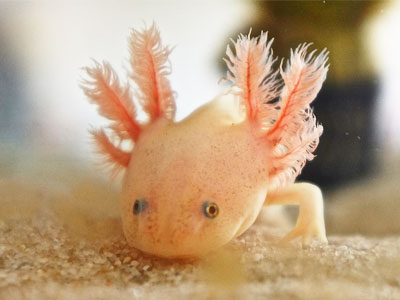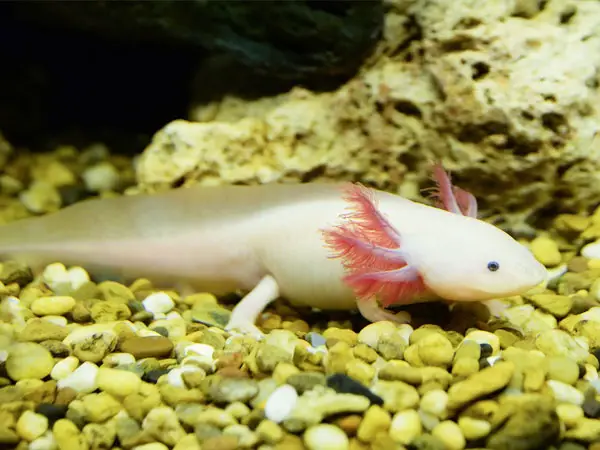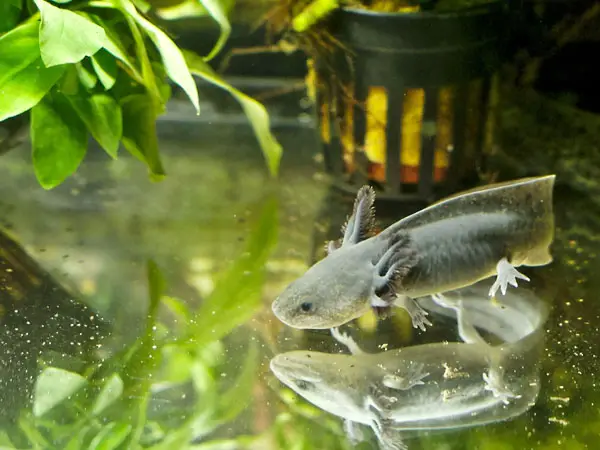
Unlike humans, some animals have the remarkable ability to regenerate body parts. Among vertebrates, axolotls are unrivalled in their ability to regrow gills, tails, limbs, and other body parts and internal organs.
Although the axolotl is not unique in its ability since other salamanders are also capable of regeneration, the axolotl is the best model among all salamanders for research into their regenerative capabilities.
As such, it is no wonder then that the axolotl counts as one of the most scientifically researched salamanders in the world.
With a complex genome that has been sequenced by scientists, the secrets behind the outstanding regeneration ability of axolotls are starting to unveil.
In this article, I’m going to discuss how axolotl regeneration works, why is it important for us to know more about how axolotl regenerate their body parts, which body parts can axolotls regenerate, and what you should do if your axolotls loses a limb or its gills.
Axolotl Regeneration
With a recently sequenced genome, scientists have uncovered that the axolotl has a remarkably complex genome with 32 billion base pairs. The human genome, on the other hand, is a dwarf in comparison having only 3 billion base pairs.
With an improved map of their DNA, scientists are beginning to understand better why axolotls manage to regrow a perfect replica of nearly any body part.
In simple terms, once a limb of an axolotl is severed, the wound site bleeds very little and heals over in a matter of hours. A wound epidermis is quickly formed by cells that work to cover the wound site.
In the next couple of days, the cells of the wound epidermis divide and grow rapidly forming a blob (cone-shaped structure called a blastema), which then undergoes growth and patterning to form a new limb.
Which Cells are Responsible for Regeneration?
The blob that forms after the wound site heals over — blastema in scientific terms — is essentially a mixture of several different cell types derived from nearby tissue that regenerate muscle, bone, cartilage and skin.
Each cell type has a well-defined role (e.g. skin cells grow skin, muscle cells grow muscle, and so on), but then there are other cells as well that can lose their identity (dedifferentiation) and act like stem cells to regrow skin, muscles or bone.
What’s even more interesting is the fact that the limb only regenerates the missing part. How does the limb know how to do that?
Scientists have tested this by amputating a limb and transplanting a blastema elsewhere on the body to see how it regenerates. Amazingly, the blastema from the amputated limb knew exactly what it was supposed to be and regrew normally.
This is lead researchers to conclude that cells have something called positional memory or positional identity.
It’s not clear how limbs know to stop growing after reaching the right size and whether the same mechanisms involved in re-growing limbs are responsible for re-growing internal organs.
But with the genome sequence now publicly available, more researchers are beginning to study the axolotl’s regenerative capabilities that for us humans seem like something straight out of a sci-fi movie.
Can axolotl limbs regrow indefinitely?
Researchers were also curious to find out whether there’s a cap on the regenerative capabilities of axolotls.
Turns out this ability is definite and axolotl limbs can’t regrow indefinitely after repeated amputations. Researchers have found that after about 5 amputations, the limbs stop re-growing.
What Body Parts Can Axolotls Regenerate
Axolotls can regenerate nearly any body part, some of them fully (e.g. limbs), others only partially (e.g. brain).
Besides their arms, legs and tails, axolotls can regenerate many other body parts including internal organs.
Scientists have studied the axolotl’s ability to regenerate their lungs, hearts and ovaries. They’ve also found that an axolotl can regrow a millimeter-by-2-millimeter square of their forebrain, called telencephalon.
Axolotls can even regenerate a crushed spinal cord in about three weeks and be able to use their legs and tail again. They can even regenerate their reproductive organs.
Another amazing feat is their ability to regenerate the pumping machinery of their heart (heart ventricle) in about 30 to 60 days. Compared to humans, whose hearts can fail due to a blockage in a heart vessel, axolotls are indeed superhuman.
How Long Does it Take Axolotls to Regenerate Lost Limbs?
The time it takes axolotls to regenerate a limb depends on factors such as age and body size. A juvenile axolotl is able to regenerate faster compared to an older axolotl.
A juvenile axolotl may regrow a lost limb in 40-50 days. Good nutrition coupled with excellent water conditions will certainly help along in the process.
Applications in Human Medicine
While there are still many unanswered questions about the regenerative powers of axolotls, researchers are already finding potential applications of this research in human tissue regrowth.
For example, researchers are looking into improving prospective stem cell therapies in aging human eyes by studying axolotl retinas. Likewise, the ability of axolotls to rapidly regrow their lungs could help us in finding ways to regenerate human lungs.
Scientists are also hoping to uncover a way to regulate the environment around cancer cells and force them to grow normally.
Do Axolotls Get Cancer?
It may appear that since axolotls can frequently regrow lost limbs, they may be more prone to cancer since cancer and regeneration are connected. However, unlike cancer, which is an out-of-control growth of cells, regeneration in axolotls is very much a well-controlled process.
Therefore, by uncovering all the mechanisms that govern the regenerative growth of cells in axolotls, scientists may be able to crack how a carcinogen can be “reprogrammed” for regenerative growth.
How Long Do Axolotls Live?
Despite these superhuman feats of regeneration, axolotls are not immortal. The lifespan of salamanders varies by species and they can live anywhere between 3 to 55 years. In this range, however, axolotls are on the shorter end with a lifespan of 10 to 15 years.
Some axolotls can live a little over 15 years if they’re fed a good diet and kept in great conditions, but most axolotls will not live longer than 15 years.
Axolotls are also not immune to diseases. Fungal infections, parasitic infections, hyperthermia, stress, impaction, ammonia poisoning and other diseases can all cause their demise.
Even secondary infections from an injury can pose a threat if water conditions in their tank are precarious.
Therefore, just because your axie is endowed with the gift of regeneration, it doesn’t mean you shouldn’t take good care of it.
You should feed your axies good quality live foods, perform regular water changes, monitor water parameters closely, avoid stressful conditions, and pay attention to signs of diseases.
Axolotls have sensitive skins that leaves them exposed to toxins and chemicals, so it’s essential to pay attention to what you are introducing to their environment.
Just because they’re able to regenerate their body parts, it doesn’t mean they can’t ever get sick from seemingly banal things like a fungal infection.
Are Axolotls Smart?
Axolotls aren’t especially smart. They’re known to be very inquisitive of what’s going on in their tank and surroundings, they can recognize shapes and organisms from a distance and they even recognize people that feed them.
It’s safe to say that like most other creatures, axolotls are preoccupied with finding food and occasionally mating, and not much else.
According to one study, salamanders can count to at least three and can discriminate between larger numbers of flies.
What to Do If Your Axolotl is Injured
Injuries to your axolotl can happen if you’re keeping your axolotl in the same aquarium with other axolotls or other freshwater fish.
Axolotls are known to exhibit cannibalistic behavior and may snap down on the limbs and gills or other axolotls. This trait is more pronounced in juvenile axolotls that are kept in the same aquarium but may also happen among adult axolotls as well.
Keeping them in larger aquariums, with plenty of space and hiding spaces can greatly reduce the number of such incidents.
Even so, axolotls don’t actually need any tank mates. They can be kept on their own as they don’t get sad or stressed if being raised alone.
If kept with fish smaller than them, there’s a high probability that axolotls will eat said fish. Keeping axolotls with larger fish, however, carries the risk of fish nipping at the limbs and gills of axolotls.
Either way fish aren’t good tank mates for axolotls, especially fish that can rapidly breed since a large number of fish will stress out axolotls.
As you’ve seen from this article on axolotl regeneration, an axolotl losing a limb is not the end of the world. They simply regrow it. The real issue is an infection caused by opportunistic bacteria.
Therefore, if your axolotl gets injured because of a tankmate, it’s best to remove that tank mate and to make sure the water is clean, and all water parameters are in the ideal range.
Given the right tank conditions, an injury is far from being a death sentence for your axolotl, but it’s best not to stress your axolotls with nippy tank mates.
Why is the Axolotl Going Extinct?
Despite their supernatural regeneration capabilities, axolotls are a critically endangered species. Axolotls can only be found in the wild in the Xochimilco Lake complex in Mexico and their numbers have dramatically decreased in the last couple of years.
At one point, the axolotl was feared completely extinct, but scientists did manage to find wild specimens still.
Even though axolotls can quickly recover from injuries, they aren’t immune to water pollution and loss of habitat, two of the biggest dangers to them in the wild.
The use of chemical fertilizers and pesticides in large-scale farming in the area and the introduction of invasive species that aren’t native to these lands (Asiatic carp and Tilapia, an African fish species) have decimated the number of wild axolotls.
These invasive fish species compete with axolotls for resources and they even eat up their eggs. Plus, injured axolotls lose their ability to efficiently find food and ultimately die before their regenerative process can complete.
Agricultural runoff has caused plant life to boom so much so that endemic species are becoming deprived of oxygen. Apart from agricultural runoff, the lake is also at risk of being polluted with human waste that comes from the overflowing of sewer systems because of strong storms.
Captive populations are also at risk because of the lack of genetic diversity. Captive axolotl stocks are extremely inbred. Axolotls populations raised in research facilities are also not safe as diseases and accidents can wipe out an entire lab population.
Therefore, scientists and conservationists are racing against the clock to try to save the axolotl. Working together with local farmers, reducing the number of invasive species, reducing and eliminating pesticide use and chemical fertilizers, and creating a healthy sanctuary for axolotls will be crucial in this fight.
Hopefully, it’s not too late for these rehabilitation efforts, and we haven’t yet reached a point of no return, when all efforts to save the axolotl will become futile.
Conclusion
As scientists are doing more research on axolotl regeneration, it will be interesting to see what the axolotl can teach us about potentially re-growing human limbs or internal organs.
While the axolotl is not singular in its ability to regenerate body parts — there are many other animals that can do it (e.g. flatworms, lizards, Teleost fish, frog tadpoles, terrestrial salamanders, etc.) — axolotls are unique in the sense that they maintain this ability to regenerate throughout their entire lives.
Axolotls are also unique in the sense that they can regrow a perfect copy of a severed limb much faster compared to terrestrial salamanders.
In the light of all these, it’s no wonder that axolotls are one of the most scientifically researched salamander species in the world and a model for research into tissue regeneration.
Hopefully, the axolotl genome can lend humans insight into lessons that we can apply to human health, and we too will soon be able to regenerate skin tissue or internal organs.




